New research says that polar bears are starving as climate change accelerates and that these animals can go extinct in another 80 years. In many regions, the species is already struggling. With global warming, the sea ice is shrinking and the polar bears are cut short of seal hunting space and time and this could lead to the extinction of the species as reported in Nature Climate Change.
"With high greenhouse gas emissions, steeply declining reproduction and survival will jeopardize the persistence of all but a few high-Arctic subpopulations by 2100," write the researchers.

Moderate greenhouse gas emissions would simply prolong the persistence of the species but it is most unlikely "to prevent some subpopulation extirpations within this century," according to researchers.
Even the reducing bodyweight of such bears will undermine their chances of surviving Arctic winters without food, as bears face longer durations of fasting before they go out to feed again.
Two Factors
Scientists show two factors that will lead to extinction. One is that the fasting duration of these animals differs according to many regions from six years or more. The other is the climate change estimates that track the reducing sea ice levels.

Studying the current climate trends, the scientists concluded that 12 polar bear habitats out of the total would have been decimated as the year 2100 arrives. This is mainly due to the high pace of climate change in the Arctic, as it is warming twice as fast as the whole planet.
An author of the study, Steven Amstrup, a chief scientist of Polar Bears International, told AFP that new births of these white-furred animals will be "severely compromised" in almost all regions except the Queen Elizabeth Island's subpopulation of Canada's Arctic Archipelago.
Further, estimates say that Earth's average surface temperature will rise by 3.3 degrees Celsius above the preindustrial times. Right now, just a degree rise in warming has triggered a peak of heatwaves, droughts and superstorms by the rising sea.
Inability to Adapt to Environment
If we can cap the global warming at just half-a-degree above Paris Agreement targets, it would just delay the polar bears' collapse, according to the report.
Reduction of the depletion of sea ice is the only way polar bears can be saved, as far as what we can do. But the main threat to the species is its inability to adapt to the changing environment, Amstrup told Phys.org.
Around 25,000 polar bears (Urus maritimus) are left in the wild today.
The polar bear is considered as 'vulnerable' on the IUCN Red List of endangered species and not as 'endangered' or 'critically endangered'. The authors say that the status attributed does not reflect the plight of the species.









